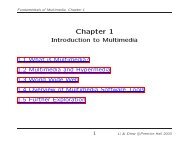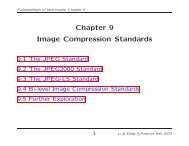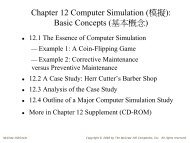Fundamental Concepts in Video
Fundamental Concepts in Video
Fundamental Concepts in Video
You also want an ePaper? Increase the reach of your titles
YUMPU automatically turns print PDFs into web optimized ePapers that Google loves.
<strong>Fundamental</strong>s of Multimedia, Chapter 5<br />
S-<strong>Video</strong> — 2 Signals<br />
• S-<strong>Video</strong>: as a compromise, (Separated video, or Supervideo,<br />
e.g., <strong>in</strong> S-VHS) uses two wires, one for lum<strong>in</strong>ance<br />
and another for a composite chrom<strong>in</strong>ance signal.<br />
• As a result, there is less crosstalk between the color <strong>in</strong>formation<br />
and the crucial gray-scale <strong>in</strong>formation.<br />
• The reason for plac<strong>in</strong>g lum<strong>in</strong>ance <strong>in</strong>to its own part of the<br />
signal is that black-and-white <strong>in</strong>formation is most crucial for<br />
visual perception.<br />
– In fact, humans are able to differentiate spatial resolution <strong>in</strong> grayscale<br />
images with a much higher acuity than for the color part of<br />
color images.<br />
– As a result, we can send less accurate color <strong>in</strong>formation than must<br />
be sent for <strong>in</strong>tensity <strong>in</strong>formation — we can only see fairly large blobs<br />
of color, so it makes sense to send less color detail.<br />
4 Li & Drew c○Prentice Hall 2003












